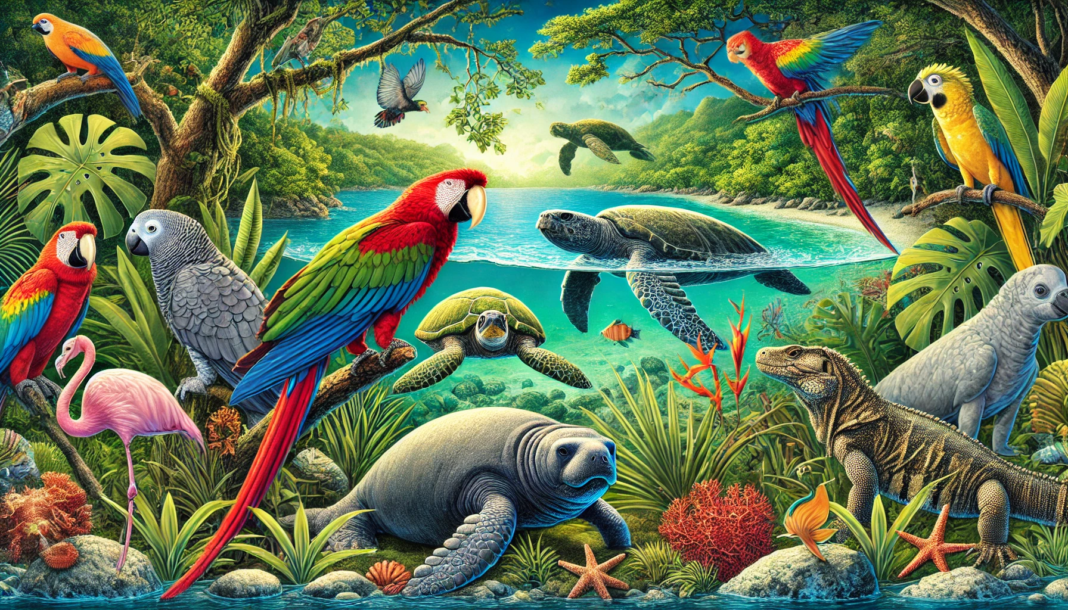The Caribbean is home to an incredible diversity of life, including numerous species that are found nowhere else in the world.
However, many of these species are threatened or endangered due to various factors, including habitat loss, climate change, and human activities.
This article explores some of the most notable endangered species in the Caribbean, highlighting their unique characteristics and the conservation efforts underway to protect them.
Notable Endangered Species in the Caribbean
Puerto Rican Parrot (Amazona vittata)
The Puerto Rican Parrot, also known as the Puerto Rican Amazon, is one of the most endangered birds in the world. Once abundant throughout the island of Puerto Rico, the population of these vibrant green parrots has dramatically declined due to habitat destruction, hurricanes, and poaching. The remaining wild populations are primarily found in El Yunque National Forest and the Río Abajo State Forest.
Conservation Efforts
Conservation efforts for the Puerto Rican Parrot include captive breeding programs, habitat restoration, and the establishment of protected areas. The U.S. Fish and Wildlife Service, along with local and international partners, has been working to reintroduce captive-bred parrots into the wild and monitor their progress.
West Indian Manatee (Trichechus manatus)
The West Indian Manatee, often called the sea cow, is a large marine mammal that inhabits the shallow coastal waters and rivers of the Caribbean. These gentle herbivores are slow-moving and depend on seagrass beds for food. Manatees face threats from boat collisions, habitat loss, and water pollution, which have led to significant population declines.
Conservation Efforts
Efforts to protect the West Indian Manatee include the establishment of marine protected areas, speed regulations for boats, and public awareness campaigns to reduce human-related threats. Organizations like the Save the Manatee Club work to raise awareness and support conservation initiatives.
Hawksbill Turtle (Eretmochelys imbricata)
The Hawksbill Turtle is a critically endangered sea turtle species known for its distinctive patterned shell. These turtles play a crucial role in maintaining the health of coral reefs by feeding on sponges. Hawksbill Turtles are threatened by illegal poaching for their shells, habitat loss, and climate change, which affects their nesting sites.
Conservation Efforts
Conservation measures for Hawksbill Turtles include protecting nesting beaches, regulating trade in turtle products, and conducting research and monitoring programs. International agreements like the Convention on International Trade in Endangered Species (CITES) help control the trade of Hawksbill Turtle shells.
Jamaican Iguana (Cyclura collei)
The Jamaican Iguana is a critically endangered reptile species endemic to Jamaica. Once thought to be extinct, the species was rediscovered in the Hellshire Hills in 1990. Jamaican Iguanas are threatened by habitat loss due to deforestation and predation by invasive species such as mongooses and feral cats.
Conservation Efforts
Conservation efforts for the Jamaican Iguana include habitat protection, captive breeding, and reintroduction programs. The Hope Zoo in Jamaica plays a significant role in breeding and releasing iguanas into the wild. Efforts also focus on controlling invasive species and restoring the iguana’s natural habitat.
Montserrat Oriole (Icterus oberi)
The Montserrat Oriole is a critically endangered bird species found only on the island of Montserrat. The population of this striking black and yellow bird has declined due to habitat destruction caused by volcanic eruptions and hurricanes. The oriole’s primary habitat, the Montserrat Forest, has been severely impacted, leading to a decrease in suitable nesting sites.
Conservation Efforts
Efforts to protect the Montserrat Oriole include habitat restoration, the creation of protected areas, and monitoring population trends. The Montserrat National Trust and other organizations work to raise awareness and promote conservation actions to safeguard the oriole’s habitat.
Cuban Crocodile (Crocodylus rhombifer)
The Cuban Crocodile is a critically endangered crocodile species native to Cuba. Known for its distinctive bumpy scales and relatively short snout, this crocodile is found in the Zapata Swamp and the Isla de la Juventud. The species faces threats from habitat destruction, hunting, and hybridization with the American Crocodile.
Conservation Efforts
Conservation initiatives for the Cuban Crocodile include habitat protection, captive breeding, and public education campaigns. The Cuban government and conservation organizations work together to protect critical habitats and prevent poaching.
Factors Contributing to Endangerment
The endangered status of these species is often due to a combination of factors, including:
Habitat Loss
The destruction of natural habitats due to agriculture, urban development, and deforestation is a significant threat to many Caribbean species. The loss of forests, wetlands, and coastal areas reduces the available space for species to live, feed, and reproduce.
Climate Change
Climate change has far-reaching impacts on the Caribbean’s ecosystems. Rising sea levels, increased temperatures, and changing precipitation patterns can alter habitats and affect the availability of food and water. Coral bleaching, caused by warmer ocean temperatures, poses a significant threat to marine species like the Hawksbill Turtle.
Invasive Species
The introduction of non-native species can disrupt local ecosystems and outcompete or prey on native species. Invasive plants, animals, and pathogens can significantly impact biodiversity and contribute to the decline of endangered species.
Human Activities
Human activities, such as poaching, overfishing, and pollution, directly threaten many species. The illegal wildlife trade, for example, targets species like the Hawksbill Turtle for their shells, while pollution can contaminate water sources and harm marine life.
Conservation Efforts and Success Stories
Conservation efforts across the Caribbean aim to protect endangered species and restore their habitats. These efforts include:
Protected Areas and Reserves
The establishment of national parks, marine reserves, and wildlife sanctuaries is crucial for preserving habitats and protecting species. These protected areas provide safe havens for endangered species and help maintain ecological balance.
Captive Breeding and Reintroduction
Captive breeding programs play a vital role in conserving species with critically low populations. Breeding endangered animals in captivity and reintroducing them into the wild can help increase population numbers and genetic diversity.
Research and Monitoring
Ongoing research and monitoring are essential for understanding the status of endangered species and identifying threats. Conservationists use data from field studies to develop effective management plans and track the success of conservation initiatives.
Community Engagement and Education
Community involvement is key to successful conservation efforts. Educating local communities about the importance of biodiversity and sustainable practices can foster a sense of stewardship and encourage participation in conservation activities.
Conclusion
The Caribbean’s rich biodiversity is under threat, with many species facing the risk of extinction. However, through dedicated conservation efforts, there is hope for the protection and recovery of these endangered species. By raising awareness, supporting conservation initiatives, and promoting sustainable practices, we can help preserve the unique and irreplaceable natural heritage of the Caribbean. Protecting these species is not only a moral obligation but also essential for maintaining the health and resilience of the region’s ecosystems.
FAQs
What are some of the most endangered species in the Caribbean?
Some of the most endangered species in the Caribbean include the Puerto Rican Parrot, West Indian Manatee, Hawksbill Turtle, Jamaican Iguana, Montserrat Oriole, and Cuban Crocodile.
What are the main threats to endangered species in the Caribbean?
The main threats to endangered species in the Caribbean include habitat loss, climate change, invasive species, and human activities such as poaching and pollution.
How can we help protect endangered species in the Caribbean?
To help protect endangered species in the Caribbean, individuals can support conservation organizations, promote sustainable practices, avoid purchasing products made from endangered species, and participate in community conservation efforts.
What is the role of protected areas in conservation?
Protected areas play a crucial role in conservation by providing safe habitats for endangered species, preserving biodiversity, and supporting ecosystem functions. They help mitigate the impacts of human activities and provide opportunities for research and education.
Are there any successful conservation stories in the Caribbean?
Yes, there have been successful conservation stories in the Caribbean, such as the recovery efforts for the Puerto Rican Parrot and the establishment of protected areas for the Hawksbill Turtle. These successes demonstrate the positive impact of dedicated conservation initiatives.
What is the importance of biodiversity in the Caribbean?
Biodiversity is essential for the health and stability of ecosystems in the Caribbean. It supports ecosystem services such as pollination, water purification, and climate regulation. Biodiversity also contributes to the region’s cultural and economic well-being, including tourism and traditional practices.

